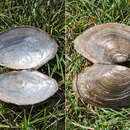Sinanodonta woodiana, the Chinese pond mussel, Eastern Asiatic freshwater clam or swan-mussel, is a species of freshwater mussel, an aquatic bivalve mollusk in the family Unionidae, the river mussels.
Distribution
- indigenous in Eastern Asia
- non-indigenous in Europe:
- Austria
- Belgium
- Croatia
-
Czech Republic – non-indigenous in Bohemia since 2001,[2] non-indigenous in Moravia since 1996;[3][4][5] not evaluated (NE)[2]
- France
- Germany
- Greece[6]
- Hungary
- Italy
- Poland
- Romania[7]
- Serbia [8]
- Slovakia [9]
- Spain[10]
- Ukraine
- Switzerland
- non-indigenous in some Indonesian islands
- non-indigenous in America:
Extirpated in New Jersey US.
Asia
Ecology
Sinanodonta woodiana is a species of East Asian unionid mussel, primarily from the Amur River and Yangtze rivers. The Chinese pond mussel can reach sizes of up to 30 cm and an age of 12–14 years. Yet, they can reproduce in their first year while only 3–4 cm in size.[12]
This large freshwater mussel is a habitat generalist with high silt tolerance. It is established worldwide despite having, like all unionid mussels, an obligatory parasitic stage (glochidium), which must encyst on host fish. The species is a broad host generalist, which can complete its development on all fish species tested, both coinvasive and native.[13] The presence of S. woodiana can seriously influence indigenous unionid populations.
Sinanodonta woodiana's great success is attributed to importation and commercialization of Asian carp, its native host. S. woodiana was introduced in Tuscany both inadvertently, and for artificial pearl production. The species is also sold in garden centers as biofiltration for artificial ponds.
Parasites:
References
-
^ Cummings, K. (2011). "Sinanodonta woodiana". IUCN Red List of Threatened Species. 2011: e.T166313A6198609. doi:10.2305/IUCN.UK.2011-2.RLTS.T166313A6198609.en. Retrieved 20 November 2021.
-
^ a b Beran, L. (2002) Vodní měkkýši České Republiky – rozšíření a jeho změny, stanoviště, šíření, ohrožení a ochrana, červený seznam. Aquatic molluscs of the Czech Republic – distribution and its changes, habitats, dispersal, threat and protection, Red List. – Sborník přírodovědného klubu v Uherském Hradišti, Supplementum 10, 258 pp.
-
^ Beran L. (1997). "First record of Sinanodonta woodiana (Mollusca: Bivalvia) in the Czech Republic". Acta Societatis Zoologicae Bohemicae 61: 1–2.
-
^ Novák J. (2004) Třetí potvrzený nález škeble asijské v ČR. https://www.biolib.cz/cz/article/id2/
-
^ (in Czech) Horsák M., Juřičková L., Beran L., Čejka T. & Dvořák L. (2010). "Komentovaný seznam měkkýšů zjištěných ve volné přírodě České a Slovenské republiky. [Annotated list of mollusc species recorded outdoors in the Czech and Slovak Republics]". Malacologica Bohemoslovaca, Suppl. 1: 1–37. PDF.
-
^ (PDF) https://www.reabic.net/journals/bir/2021/Accepted/BIR_2022_Karaouzas_etal_correctedproof.pdf.
{{cite journal}}: Cite journal requires |journal= (help); Missing or empty |title= (help) -
^ Popa, Oona P.; Kelemen, Beatrice S.; Murariu, Dumitru; Popa, Luis A. (2007). "New records of Sinanodonta woodiana (Lea, 1834) (Mollusca: Bivalvia: Unionidae) from Eastern Romania". Aquatic Invasions. 2 (3): 265–267. doi:10.3391/ai.2007.2.3.12.
-
^ Distribution of Anodonta (Sinanodonta) woodiana (Rea, 1834) in inland waters of Serbia "Archived copy" (PDF). Archived from the original (PDF) on 2009-04-19. Retrieved 2007-05-17.
{{cite web}}: CS1 maint: archived copy as title (link) -
^ Nagel K.-O. & Šteffek J. 2005: Sinanodonta woodiana (Lea) na východnom Slovensku. – Telekia (Michalovce), 3: 35–36.
-
^ Pou-Rovira, Q.; R. Araujo; D. Boix; M. Clavero; C. Feo; M. Ordeix & L. Zamora (2009). "Presence of the alien chinese pond mussel Anodonta woodiana (Lea, 1834) (Bivalvia, Unionidae) in the Iberian Peninsula" (PDF). Graellsia. 65 (1): 67–70. doi:10.3989/graellsia.2009.v65.i1.137.
-
^ Vikhrev, I. V., Konopleva, E. S., Gofarov, M. Y., Kondakov, A. V., Chapurina, Y. E., & Bolotov, I. N. (2017). "A Tropical Biodiversity Hotspot Under the New Threat: Discovery and DNA Barcoding of the Invasive Chinese Pond Mussel Sinanodonta Woodiana in Myanmar". Tropical Conservation Science 10: 1940082917738151.
-
^ US Fish and Wildlife Service, 2015. "Chinese Pond Mussel (Sinanodonta woodiana) Ecological Risk Screening Summary" [1]
-
^ Douda, K., Vrtílek, M., Slavík, O., & Reichard, M. (2012). The role of host specificity in explaining the invasion success of the freshwater mussel Anodonta woodiana in Europe. Biological Invasions 14:127–137.[2].
-
^ Pavljuchenko, O. V. (2005) The first record of the helminth Aspidogaster conchicola (Aspidogastrea) in Sinanodonta woodiana (Mollusca, Bivalvia) from Ukraine. – Vestnik Zoologii, Schmalhausen Institute of Zoology, National Academy of Sciences of Ukraine, Vol. 39(3): page 50.


